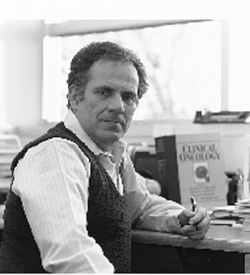Our Science – Ruscetti Website
Francis W. Ruscetti, Ph.D.
 |
|
|||||||||||||||||||||||||
Biography
Dr. Frank Ruscetti is Head of the Leukocyte Biology Section, Laboratory of Experimental Immunology, NCI at Frederick in the Center for Cancer Research. He obtained his Ph.D. from the University of Pittsburgh working on prokaryotic RNA metabolism under Lew Jacobsen; did post-doctoral work on hematopoiesis under Dane Boggs. From 1975-1983, he studied human retroviruses and T-cell biology in Laboratory of Tumor Cell Biology, NCI.
Research
Cell cycle control of cell growth and differentiation is tightly regulated by a series of complex interactions. It is the main tenet of our studies that unrestricted growth control and inappropriate transcriptional activation, due to defects in negative regulatory control, play a major role in oncogenesis and retroviral pathogenesis.
Transforming growth factor-beta: Growth inhibition of stem cells. In studying negative regulation of hematopoietic stem cell (HSC) growth, we have found TGF-beta selectively inhibits the growth of all primitive stem cell populations isolated. Both in vivo and in vitro experiments have shown that HSC are reversibly prevented from entering the cell cycle after TGF-beta1 treatment regardless of the growth stimulant used. In single cell assays, using highly purified murine HSC, growth inhibition by TGF-beta1 was direct. Future projects include disruption of TGF-beta growth regulation in stem cell lines and fresh stem cells to test for oncogenic potential and clone genes involved in TGF-beta regulation of HSC growth.
Negative regulation of viral and cellular genes during retroviral infection. We previously demonstrated HIV-1 latency in monocytes in vivo. The presence of latently infected monocytes constitutes a possible source for reactivation of virus production during the normal immune response. We have identified immune activation of latently infected monocytes to be a mechanism by which latent HIV-1 can be reactivated to produce infectious virus. Ongoing studies involve identification of these genes as well as signal transduction pathways involved in immune activation of latent HIV-1.
The development of the appropriate immune response mediates microbial resistance. However, several studies suggest that in some cases an infectious agent can stimulate inappropriate cytokine responses, thus increasing the pathology caused by that agent. Since CD4+ T-cells are the preferential targets of HIV, much interest has developed over the TH1-TH2 cytokine responses during HIV infection and pathogenesis. It has been proposed that a preferential replication of HIV in TH2 and TH0 over TH1 cells occurs in the development of AIDS. However, studies in our lab showed similar levels of viral replication in TH1, TH2 and TH0 cells. In TH2 cells, HIV-mediated apoptosis was delayed and less in magnitude than in some TH1 clones over a 7-14 day culture period. Current studies address the mechanism(s) of the differential apoptosis in TH1 and TH2 cells.
Although largely unknown, the cellular events triggered by HTLV-1 infection in the lymphoproliferative process are of major importance to the establishment of leukemia. We have recently characterized an infectious clone of HTLV-1 as well as a susceptible expressing cell line to study the molecular interactions of this infectious clone. We have shown this infectious clone to be highly transforming for T-cells. Future studies include delineating viral elements necessary for cytokine dependent and independent transformation as well as the signalling pathways, initiated by HTLV-1, resulting in T cell immortalization.
This page was last updated on 9/4/2008.

